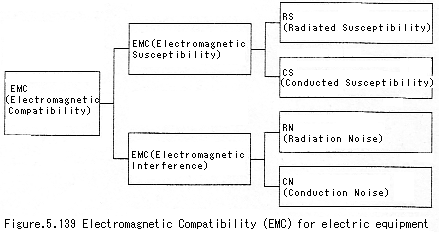Noise
A DC/DC converter with a high frequency system has the considerably important features of being small in size and high in efficiency.
However, since the converter is, in principle, likely to be a noise source, special care should be taken to ensure that the noise is fully
suppressed or at least reduced as much as possible. The types of noise can be classified as shown in Fig. 5.139. High-frequency switching
high power components such as the DC/DC converter have not been in the vehicles of conventional engine before.
The Electromagnetic Interference (EMI) in order to suppress the noise, which is becoming one of the majorissues. This noise problem of the
DC/DC converter from the viewpoint of the vehicle will be described below, for example, the car-installed radios.
Radios uesd in Japan have the following radio frequency bands:
- AM band radio: The frequency range is between 522 kHz to 1629 kHz.
- FM band radio: The frequency range is between 76 MHz to 108 MHz.
As shown above, both the AM and FM band radios have a wide ranging frequency band. Consequently, the noise from the DC/DC converter, in most
cases, can reach the receiver in different ways: directly through lines connecting the source of the noise to the receiver (i.e., by conduction),
or directly via radiation. Strict examinations to determine whether this happens by conduction or radiation is necessary in order to take proper
counter measures for each specific case. Needless to say, it is most important to reduce the noise generation of the DC/DC converter of the DC/DC
converter. However, since the converter is connected to many load applying factors on the vehicle side, we should consider to improve vehicle
systems sometimes.
As many motor vehicle users equip their vehicles with various devices after their purchase. We should consider the frequency bands of the radio
equipment such as ham radio apparatus, or, in some regions, to long-wave and shoet-wave radio receivers furthermore. Increasing information
instruments using the ultra-high frequency (UHF) increasing, attention to these instruments is required. In electric vehicles (EVs) while recharging
the traction batteries, the DC/DC converter used to be operated, may cause noise to the outside via the battery charger.
Then we will explain the electromagnetic susceptibility (EMS).
The DC/DC converter should be designed in a way that prevents malfunction due to external electromagnetic field noise. There are many adverse phenomena
that result from malfunction. For instance, it particularly affects the vehicle headlamps.
Drivers become irritated if the power output voltage up and down by the disturbance of external electro magnetic field noise for a short period of time,
making the headlamps flicker. Becouse the degree of adverse effect on the vehicle varies depending on each vehicle, it is quite important to carry out
evaluations on the negative effects, using vehicles as well as the DC/DC converter units itself.

Reference
Book title: EV Handbook
Written by: EV Handbook Publisher's Group
Published by: Maruzen Co., Ltd. (URL http://www.maruzen.co.jp)
|
|